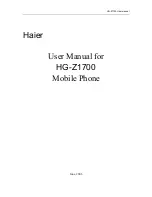
49
16
R
F
and
F
D
A
/FC
C
S
tat
em
ent
s
safety to ensure a coordinated effort at the federal
level. These agencies are:
National Institute for Occupational Safety and
Health
Environmental Protection Agency
Federal Communications Commission
Occupational Health and Safety Administration
National Telecommunications and Information
Administration
The National Institute of Health also participates in
this group.
In the absence of conclusive information about any
possible risk, what can concerned individuals do?
If there is a risk from these products—and at this
point we do not know that there is—it is probably
very small. But if people are concerned about
avoiding even potential risks, there are simple
steps they can take to do so. For example, time is a
key factor in how much exposure a person
receives. Those persons who spend long periods of
time on their hand-held mobile phones could
consider holding lengthy conversations on
conventional phones and reserving the hand-held
models for shorter conversations or for situations
when other types of phones are not available.
People who must conduct extended conversations
in their cars every day could switch to a type of
mobile phone that places more distance between
their bodies and the source of the RF, since the
exposure level drops off dramatically with distance.
For example, they could switch to
a mobile phone in which the antenna is located
outside the vehicle,
a hand-held phone with a built in antenna
connected to a different antenna mounted on the
outside of the car or built into a separate package,
or
a headset with a remote antenna to a mobile phone
carried at the waist.
Again, the scientific data do not demonstrate that
mobile phones are harmful. But if people are
concerned about the radiofrequency energy from
these products, taking the simple precautions
outlined above can reduce any possible risk.
Where can I find additional information?
For additional information, see the following
websites:
Federal Communications Commission (FCC) RF
Safety Program (select "Information on Human
Exposure to RF Fields from Cellular and PCS Radio
Transmitters"):
http://www.fcc.gov/oet/rfsafety
World Health Organization (WHO) International
Commission on Non-Ionizing Radiation Protection
(select Qs & As):
http://www.who.int/emf
United Kingdom, National Radiological Protection
Board:
http://www.nrpb.org.uk
Cellular Telecommunications Industry Association
(CTIA):
http://www.wow-com.com
U.S. Food and Drug Administration (FDA) Center
for Devices and Radiological Health:
http://www.fda.gov/cdrh/consumer/
1 Muscat et al. Epidemiological Study of Cellular
Telephone Use and Malignant Brain Tumors. In:
State of the Science Symposium;1999 June 20;
Long Beach, California.
2 Tice et al. Tests of mobile phone signals for
activity in genotoxicity and other laboratory assays.
Summary of Contents for SND251
Page 2: ......






































